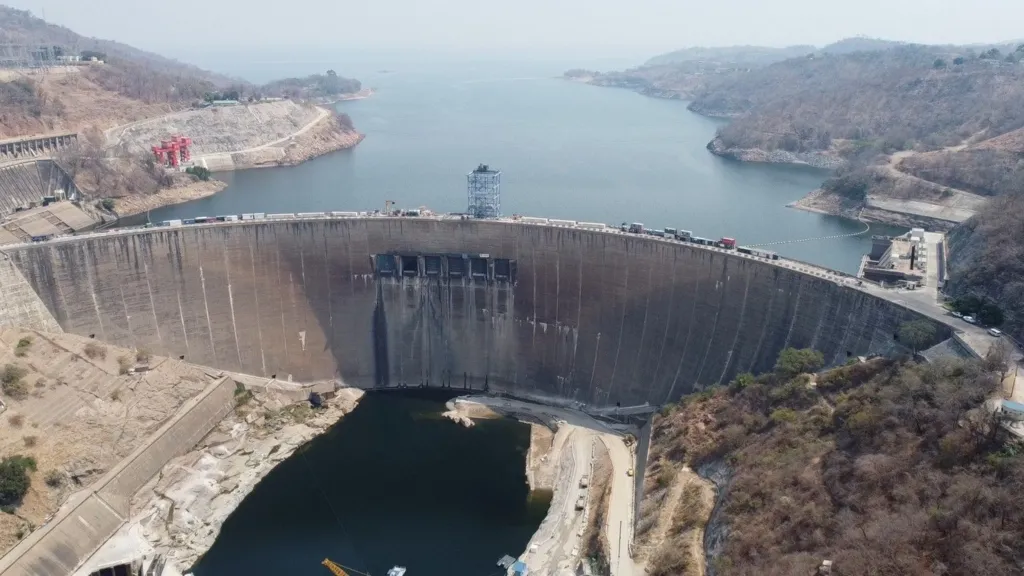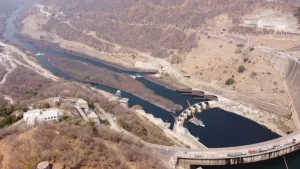How a mega dam has caused a mega power crisis for Zambia
3 min read
Kariba Dam was built in a gorge between Zambia and Zimbabwe holding back the Zambezi River to create a man-made lake.

Kariba Dam was built in a gorge between Zambia and Zimbabwe holding back the Zambezi River to create a man-made lake.
Zambia, blessed with the mighty Zambezi River and the massive Kariba Dam, is currently facing an unprecedented electricity crisis. The country is experiencing some of the worst power outages in living memory, with cities and towns enduring blackouts lasting up to three consecutive days. Residents are grateful for any brief respite, often just a couple of hours of electricity each day.
This crisis has taken many Zambians by surprise, particularly the 43% of the population connected to the electricity grid who had come to rely on a steady supply of power. The situation has been exacerbated by one of the most severe droughts in decades, linked to the El Niño weather phenomenon, which has drastically reduced Zambia’s power-generation capacity.
In many establishments, patrons are not even eating or drinking; they simply sit in darkened bars and restaurants to charge their phones amidst the hum of generators. A burgeoning business has emerged around phone charging, as many people seek to power their devices amid the outages.
Zambia relies heavily on hydroelectric power, with around 84% of its electricity coming from water reservoirs, while only 13% is generated from coal. Contributions from solar, diesel, and heavy fuel oil are minimal, accounting for just 3%. The crisis intensified recently when the country’s sole coal-fired power plant, Maamba Energy, was undergoing routine maintenance, further limiting available power.
On a brighter note, Minister of Energy Makozo Chikote announced that Maamba Energy is back at full capacity, offering hope for at least three hours of daily electricity for residents. However, the situation remains dire. President Hakainde Hichilema declared the drought a national disaster in February, yet the government’s reliance on the Kariba Dam continues to hinder progress in resolving the energy crisis.
Financial constraints have also impacted the government’s ability to import power, as suppliers require upfront payments. Nevertheless, state-owned power utility Zesco has begun importing electricity from Mozambique and South Africa to alleviate the crisis, particularly for the mining industry, which is Zambia’s primary source of foreign currency.

The Kariba Dam, built in the 1950s, serves as a reservoir for Zambia’s largest underground power station, Kariba North Bank Power Station. Due to the drought, however, only one of the six turbines is operational, generating a mere 7% of its 1,080 MW capacity. Engineer Cephas Museba, who has worked at Zesco for nearly two decades, reports unprecedented low water levels at the dam, indicating a historic decline in rainfall.
The fallout from this energy crisis is felt across all sectors of society. Businesses are reducing operating hours and laying off staff, while bakeries struggle to keep the lights on, resulting in fewer loaves of bread available. Although the government has installed generators in markets, government offices, and hospitals, the challenges persist, particularly for patients requiring consistent electricity for medical treatments.
For families, the situation is grim. Many have lost perishable food items due to extended outages, and others are forced to adjust their daily lives drastically. Cooking and heating water have become more challenging as gas supplies dwindle, leading some to revert to environmentally harmful charcoal.
The electricity crisis is also affecting water supplies. Many households rely on boreholes that require electricity or solar-powered pumps, leading to inconsistent access to water. In schools, children are advised to bring water from home to mitigate the risk of sanitation crises and potential outbreaks of waterborne diseases.
Zambians are growing increasingly frustrated and angry at the government’s inability to plan for such crises. In response, President Hichilema’s administration has pledged to improve infrastructure and diversify energy sources. Zesco is investing in additional energy solutions, including solar plants, to reduce dependence on hydroelectric power.
However, coal remains part of the strategy, with plans approved for the construction of the country’s second coal-fired power plant, despite its environmental implications. The government believes that urgent steps are necessary to prevent a recurrence of this crisis in the future.
The current energy crisis in Zambia serves as a stark reminder of the intricate balance between natural resources, climate factors, and infrastructure planning.